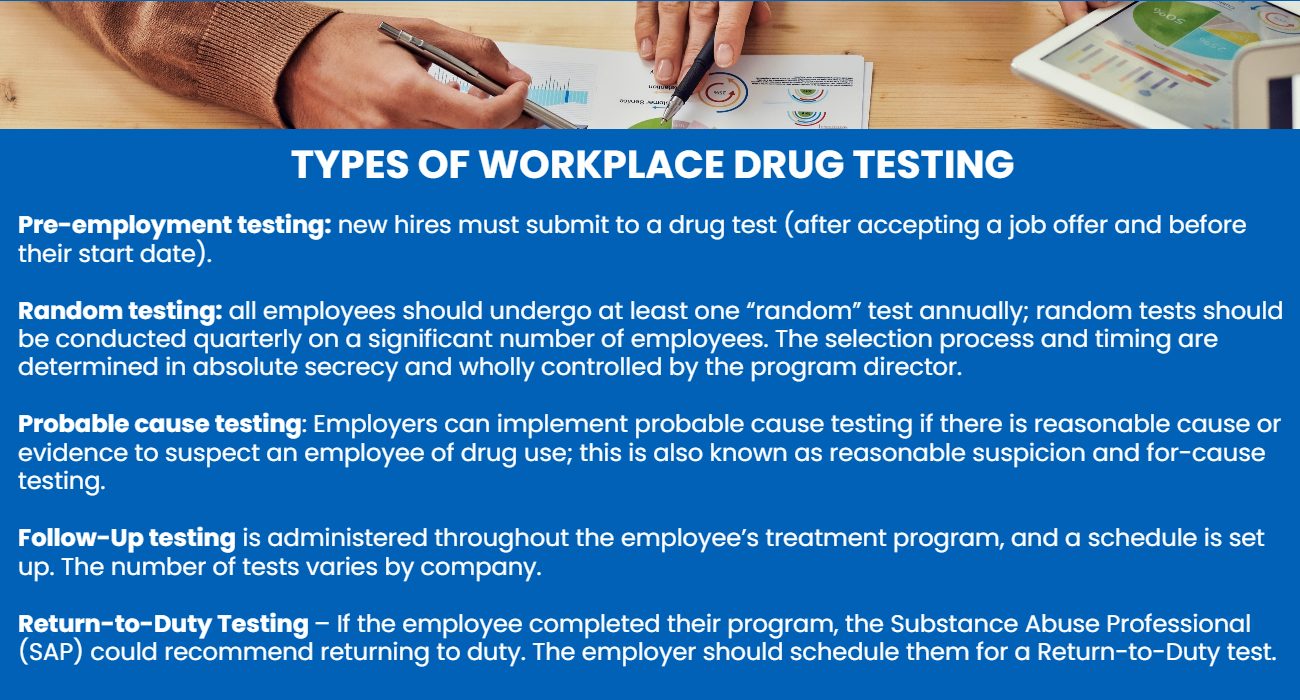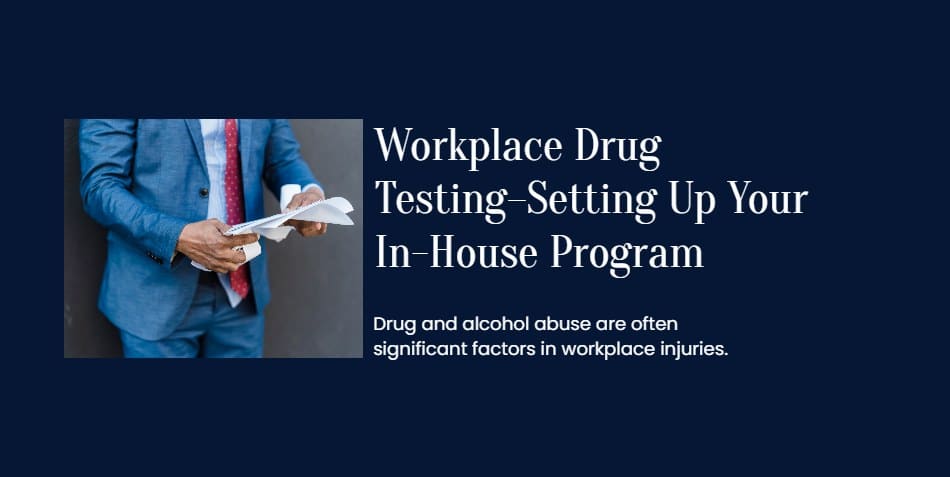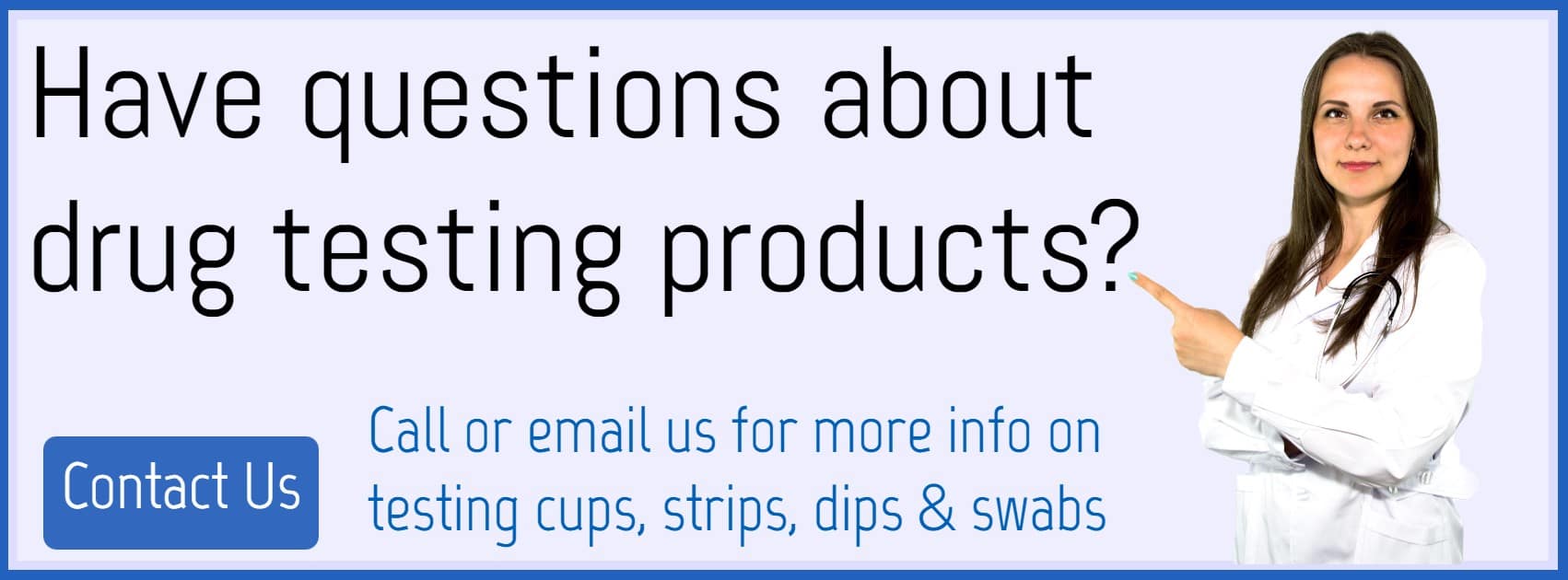Drug and alcohol abuse are often significant factors in workplace injuries. However, impaired employees may not be the only ones who suffer an injury; they are also a danger to others. Whether directly or indirectly, most workplaces are impacted to some degree by substance abuse. Workplace drug testing and the enforcement of a solid substance abuse policy can help you keep substance abuse under control.
Substance abuse and impairment at work can increase employee turnover, insurance premiums, accidents, absenteeism, errors, workers’ comp claims, and employee productivity. Substance abuse sometimes claims lives.
Even if no accidents occur, employees working under the influence of drugs or alcohol don’t perform their best; their productivity suffers, as does their accuracy—they make mistakes that can impact your company’s reputation. A significant number of companies have started implementing workplace drug testing programs.
Following the guidelines outlined here will provide you with a program that accomplishes your objectives and gives you confidence in the results.
Implementing an effective drug testing program
A drug-testing program provides employers with the opportunity to define company policies and ensure that employees abide by them. The critical elements to a successful program include:
- Addressing your company’s needs
- Drug testing
- A clearly written policy
- Educating and training employees/supervisors
- Implementing an Employee Assistance Program (EAS)
Step 1: Start with federal requirements
If your industry requires testing under law, start with those requirements.
Step 2: Training
Managers, HR managers, and safety managers are responsible for training. Employees and supervisors should understand a testing program.
It’s up to the managers to ensure the organization provides adequate training to employees and supervisors. To properly execute those responsibilities, the manager should be thoroughly trained in all aspects of the workplace drug testing program. Practical manager training would include:
- Addressing confidentiality
- Handling post-accident testing
- Pre-employment testing
- Random testing works training
- Recordkeeping requirements
- Understanding potential problems
Providing training, clear guidance, and information about your program to all the managers, supervisors and staff members gives you protection where liability is a concern and helps ensure compliance.
Training managers and supervisors provides them with the knowledge they need:
- What constitutes reasonable suspicion
- Identify behaviors typically associated with substance abuse:
- Physical signs
- Behavioral signs
- Psychological signs
- Properly document observations to meet legal requirements
- How to approach individuals who appear to have issues
Consider giving this advanced training to all management and supervisory staff who deal directly with workers on a daily basis. By disseminating this information, you help management recognize workers who have problems and make sure that responses are uniform throughout the company.
To ensure that supervisors are up-to-date on the program’s specifics and to provide them the chance to learn about any changes to rules, procedures, and the underlying legislation, you can also think about mandating such training every three years.
Step 3: Types of Testing
Pre-employment testing: new hires must submit to a drug test (after accepting a job offer and before their start date).
Random testing: all employees should undergo at least one “random” test annually; random tests should be conducted quarterly on a significant number of employees. The selection process and timing are determined in absolute secrecy and wholly controlled by the program director.
Probable cause testing: Employers can implement probable cause testing if there is reasonable cause or evidence to suspect an employee of drug use; this is also known as reasonable suspicion and for-cause testing.
Follow-Up testing is administered throughout the employee’s treatment program, and a schedule is set up. The number of tests varies by company.
Return-to-Duty Testing– If the employee completed their program, the Substance Abuse Professional (SAP) could recommend returning to duty. The employer should schedule them for a Return-to-Duty test.
When supervisors receive notification of which employees have been selected, those tests should be conducted immediately; selected employees should not be allowed to leave the premises until testing is completed. If they do leave, the test should be rescheduled for the next quarter.
Step 4: Consequences
There is no one-size-fits-all approach. Your program should clearly define the consequences.
Regular testing without clearly defined consequences will be perceived as unfair by your employees. In addition, if your policy fails to clearly define implications for an employee who tests positive for substance abuse, then you’re setting yourself up for potential legal actions.
Some organizations’ policies maintain that a single positive test is a cause for dismissal, while others prefer to issue an initial warning or suspension with a follow-up test. Other organizations allow employees to stay on, provided they participate in an employee assistance program (EAP). A Substance Abuse Professional (SAP) will evaluate the employees face-to-face to help them receive treatment.
You may want to consider the last chance agreement (LCA). These agreements detail the misconduct, set forth the employer’s expectations moving forward and define the employment consequences for failure to meet those expectations—usually termination of employment.
Your organization will need to identify and specify the approach consistent with regulatory requirements, philosophies, and safety expectations. Ensure that you apply the approach consistently and equitably.
Step 5: Tracking information
An effective drug testing program requires exceptional recordkeeping. Accurate employee information tracking provides good records if an employee contests your testing program in court or with the local unemployment office.
If you only collect the test samples and use a lab to process them, you can outsource the recordkeeping to the lab—most labs offer this as part of their services. Today’s outsourced recordkeeping systems allow you to access the information online so that you can track employee results.
Step 6: Auditing
Audit your employee list regularly to ensure everyone is tested and that nobody has slipped through the cracks. You can quickly lose track without reliable auditing.
Step 7: Build upon other’s success
Regardless of the industry, companies are aware of the repercussions impairment in the workplace can cause. A straightforward, concise drug testing program is vital to maintaining a safe and drug-free workplace. Modeling your workplace drug testing policies and procedures on what works for other organizations makes good business sense—someone has already worked out most of the kinks to the program.
Step 8: Your Company’s Needs
As mentioned earlier, in some industries, specific drug testing procedures are required by law. If you are setting up a workplace drug testing site in-house, employers need to understand why their company is drug testing to address its needs more precisely.
Step 9: Drug Testing
Various drug testing methods can be customized to meet your company’s needs, including urine and saliva. Some employers choose to continue testing randomly as an additional means of maintaining safety in the workplace and discouraging employees from using drugs.
Types of Testing to include in your substance abuse policy:
- Pre-employment
- Follow-Up Testing
- Random drug testing
- Post-accident or reasonable suspicion
- Return-to-Duty (RTD)
Decide on the methodology
- When do you want to drug test?
- Which drugs will you test for?
- A 10-panel urine drug test is the most common drug test administered. It tests for: marijuana, cocaine, opioids (including synthetic opioids), amphetamines, PCP, barbiturates, benzodiazepines, propoxyphene, methadone, and methaqualone.
- Alter your panels as trends change, i.e., rise in CBD oil usage, prescription drug abuse, and an increase in synthetic drugs.

The Written Policy
It’s vital that employers clearly define their workplace drug and substance abuse policies. If you have positions in your organization deemed “safety-sensitive,” your policy should also identify the requirements set forth by federal and state regulations.
Consider including a medical disclosure policy to inform employers of an employee taking a prescription medication that could impair them in the workplace. Employers then can remove them from dangerous work while on the medication. It also informs employees that even if they hold a valid medical prescription, impairment on the job can result in disciplinary action.
Your organization needs to define any differences in requirements, tests, and procedures for the various positions within your organization; a blanket policy will not necessarily cover all the requirements for every employee. Your policy needs to identify specific testing for each position type.
The best practice is to run any proposed policies by your company’s Legal Counsel before publishing to ensure they meet best practices and compliance standards and prevent lawsuits, fines, and fees.
Educating Your Employees
Employees should be fully aware of the workplace drug and substance abuse policy and understand their rights. Additionally, they should understand the impacts of impairment, the repercussions, and expectations while employed with the company. If an employee notices a fellow worker who may impaired, they need to know they can inform a supervisor confidentially.
A drug-free workplace provides many benefits:
- Fewer employee sick days
- Improved morale
- Increased productivity
Your On-Site Testing Facility
A company may conduct an oral fluid test on-site by someone designated within the company, such as an HR manager; oral fluid testing doesn’t require a trained collector and is impossible to cheat. The person puts a cotton swab inside their cheek for 10 seconds; it packaged up and sent to the lab.
An instant drug test (“point of care testing” (POTC) or rapid test) provides the results at the collection site, usually within a few minutes. An instant drug test typically utilizes either urine or saliva. The result is either negative (it’s not present) or non-negative (it is present). An instant drug test can’t officially give a “positive” result.
Lab-based tests can screen for any drug. Rapid testing doesn’t have all these protocols—its primary purpose is speed and to report either a “negative” or “non-negative” result. Every state has its specific mandates on how companies can test.
Whether you decide to conduct the test analysis in-house or send the test samples to a lab for testing, one of the best sources for additional in-house testing information and the necessary supplies to conduct saliva or urine drug tests, visit OvusMedical.com. Save time and money with bulk supply purchases. You can chat with us online, leave us a message, email us, or call us for additional information.
Contact Information
- Phone: 1-800-921-8241
- Email: BH@OvusMedical.com


